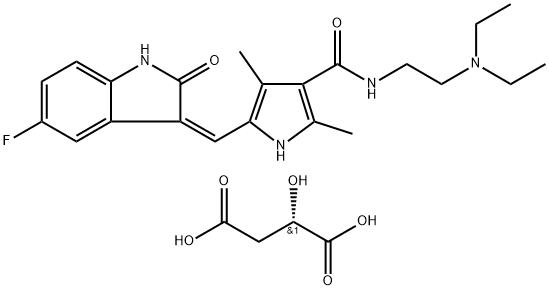Sunitinib Malate C화학적 특성, 용도, 생산
개요
Sunitinib is a small molecule inhibitor of receptor tyrosine kinases, including FLK1 (K
i = 9 nM), PDGFRβ (K
i = 8 nM), and FLT3. It is at least 10-fold selective for FLK1 and PDGFRβ over a variety of tyrosine kinases in a panel, including EGFR, Cdk2, Met, IGFR-1, Abl, and Src. Sunitinib inhibits VEGF-dependent FLK1 and PDGF-dependent PDGFRβ phosphorylation (IC
50s = 10 and 10 nM, respectively) as well as phosphorylation of FLT3 and FLT3 carrying the activating internal tandem duplication mutation (FLT3-ITD; IC
50s = 250 and 50 nM, respectively). It decreases VEGF- and FGF-induced proliferation of human umbilical vein endothelial cells (HUVECs; IC
50s = 30 and 700 nM, respectively) and reduces tumor growth in a variety of mouse xenograft models when administered at doses ranging from 20 to 80 mg/kg per day. Formulations containing sunitinib have been used in the treatment of gastrointestinal stromal tumors and metastatic renal cell carcinoma.
화학적 성질
Yellow Solid
용도
Sunitinib Malate (Sutent, SU11248) is a multi-targeted RTK inhibitor targeting VEGFR2 (Flk-1) and PDGFRβ with IC50 of 80 nM and 2 nM, and also inhibits c-Kit.
일반 설명
Sunitinib is available in 12.5-, 25-, and 50-mg capsules fororal administration for the treatment of advanced RCC andGIST upon the failure of imatinib. The agent is a multikinaseinhibitor and has been shown to inhibit PDGF-R,VEGF-R, Kit, RET, and the colony-stimulating factor receptor(CSR-1R). The result of this spectrum of activity isa slowing of tumor progression and inhibition of angiogenesisboth of which are useful in the highly vascularizedcancers, RCC and GIST. The median TTP (time to tumorprogression) was 27.3 weeks for sunitinib and 6.4 weeks with a median time of 24.1 weeks for sunitinib and 6 weeksfor placebo. The agent is well absorbed upon oral administration,and both the parent and major metabolite are highly(90%–95%) protein bound. Metabolism is mediated primarilyby CYP3A4 to give the N-desethyl derivative, which isthe major metabolite (23%–37%), equally active with theparent and undergoes further metabolism by CYP3A4. Theterminal elimination half-life for the parent and N-desethylderivative are 40 to 60 hours and 80 to 110 hours, respectively.Elimination occurs primarily via the feces. Commonadverse effects of sunitinib include fatigue, diarrhea, yellowskin discoloration, anorexia, nausea, and mucositis.Mild myelosuppression has been reported in patients withGIST including neutropenia, lymphopenia, thrombocytopenia,and anemia. There have been reports of cardiotoxicityincluding decreases in left ventricular ejectionfraction, which occurred in 11% of patients during a GISTstudy.
생물학적 활성
Potent, ATP-competitive VEGFR, PDGFR β and KIT inhibitor (K i values are 2, 9, 17, 8 and 4 nM for VEGFR -1, -2, -3, PDGFR β and KIT respectively). Also inhibits cellular receptor phosphorylation of FLT3, RET and CSF-1R. Exhibits antiangiogenic and antitumor activity in multiple xenograft models.
Sunitinib Malate 준비 용품 및 원자재
원자재
준비 용품







